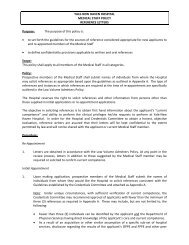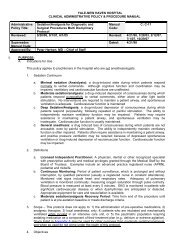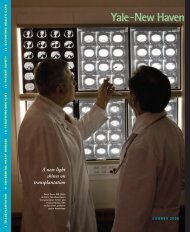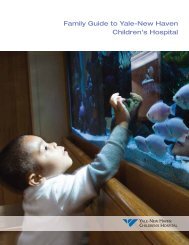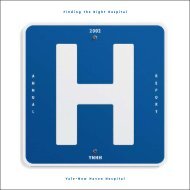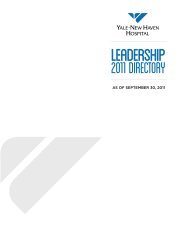Nursing Update 2009 - 2010 - Yale-New Haven Hospital
Nursing Update 2009 - 2010 - Yale-New Haven Hospital
Nursing Update 2009 - 2010 - Yale-New Haven Hospital
- TAGS
- nursing
- haven
- www.ynhh.org
You also want an ePaper? Increase the reach of your titles
YUMPU automatically turns print PDFs into web optimized ePapers that Google loves.
the sickest patients for care. The doctors<br />
and nurses who work in the Heart and<br />
Vascular Center are highly trained and<br />
experienced in helping patients recover<br />
from heart disease and complex surgery.<br />
Heart and Vascular nurse leaders have<br />
tapped into the expertise and creativity<br />
of their staff nurses to improve patient<br />
benefits and outcomes. On the Cardiac<br />
Intensive Care Unit (CICU), staff nurses<br />
have conducted research on continuous<br />
ischemia monitoring using new software<br />
called the ST-map. The study was<br />
completed in late 2008, and YNHH nurses<br />
presented the results at national nursing<br />
and medical conventions.<br />
“We worked with an outside vendor to<br />
get our bedside monitors upgraded with<br />
the ST-map software. At the same time,<br />
we secured a research mentor to help us<br />
collect and analyze the data,” explains<br />
Prasama Sangkachand, RN, service line<br />
educator, Cardiac Intensive Care Unit.<br />
“Continuous ischemia monitoring<br />
helps us identify patients with acute – but<br />
often silent – myocardial ischemia before<br />
he or she becomes symptomatic – improving<br />
patient care,” says Sangkachand.<br />
“Based on the results of this study,<br />
continuous ischemia monitoring using<br />
the ST-map is now a standard of care in<br />
the CICU.”<br />
Innovative approach helps<br />
staff help psychiatric<br />
patients<br />
In 2007, <strong>Yale</strong>-<strong>New</strong> <strong>Haven</strong> <strong>Hospital</strong><br />
estimated that more than 30 percent of<br />
non-psychiatric and non-OB patients had<br />
a secondary diagnosis of mental health<br />
issues. In 2008, that translated into more<br />
than 10,000 cases.<br />
“At first, the numbers surprised us but<br />
they really made sense when we analyzed<br />
them,” said Leslie O’Connor, APRN,<br />
director, Psychiatric <strong>Nursing</strong> Services,<br />
<strong>Yale</strong>-<strong>New</strong> <strong>Haven</strong> Psychiatric <strong>Hospital</strong>.<br />
“In the U.S., the psychiatric population is<br />
aging and developing the same pains and<br />
illnesses that the rest of us are developing.<br />
As patients, they have co-occurring<br />
psychiatric disorders that can interfere<br />
4 n u r s I n g u P D A T e<br />
During the Year of the Unit, the Staff Nurse Council was also proud of its year of accomplishments. The members<br />
shown are (front row, l-r): Mary Ann Meehan, RN, General Medicine; Roseann Della Ventura, RN, and Laurie<br />
Jonason, RN, both of the <strong>New</strong>born Special Care Unit; SNC co-chairs Nora O’Keefe, RN, Heart and Vascular<br />
Center (HVC) <strong>Nursing</strong> Procedures, and Heather Miska, RN, Children’s Psychiatric Inpatient Service; Rhonda<br />
Pattberg, RN, Labor and Birth; Shelley Harrigan, RN, Adult Primary Care Center; and Liliana Lara, RN, Post-<br />
Partum Unit. In the second row are (l-r): Sandy Cayo, RN, Medical Oncology Unit; Laurie Finta, RN, Perioperative<br />
Services, Ambulatory Services; Ebony Wright, RN, Children’s <strong>Hospital</strong> Operating Rooms; Lisa Waterbury, RN,<br />
HVC <strong>Nursing</strong> Procedures; Sybil Shapiro, RN, Shoreline Surgery Center: Endoscopy; Kelly Baran, RN, Gyn/<br />
Oncology Unit; Jason Malia, RN, Surgical Intensive Care Unit; and Deborah Gallagher, RN, Pediatric Emergency<br />
Department. Missing from photo is Mary Kelly O’Shea, RN, Pediatric Post-Anesthesia Care Unit.<br />
with their ability to participate in their<br />
own treatment and recovery.”<br />
O’Connor worked with nursing and<br />
medical staff leaders, and William H.<br />
Sledge, MD, medical director, YNHPH, to<br />
develop the Behavioral Intervention Team<br />
(BIT). The interdisciplinary BIT includes a<br />
clinical nurse leader, an advanced practice<br />
registered nurse, a social worker and a<br />
psychiatrist.<br />
BIT members train staff on the medical<br />
and surgical units where these patients<br />
are most frequently admitted. Once patients<br />
are identified, BIT members consult<br />
with clinicians – and with the patients.<br />
“With the BIT, we’re able to address<br />
the special needs of psychiatric patients<br />
on inpatient units,” said Susan King,<br />
RN, clinical nurse leader, YNHPH, and a<br />
founding member of the BIT.<br />
“BIT training is helping our nurses better<br />
care for our patients who have psychiatric<br />
needs,” explains King. “The results<br />
are very positive: patients are better able<br />
to participate in their own care, and we<br />
are providing a safe environment for the<br />
patient and staff.”<br />
nurses play pivotal role<br />
in move to patient- and<br />
family-centered care<br />
YNHH has embarked on a hospital-wide<br />
model of care known as patient- and familycentered<br />
care, and its nurses are considered<br />
the champions and educators of its core<br />
concepts: information sharing, dignity and<br />
respect, collaboration and participation.<br />
“Nurses are helping to lead the charge<br />
on this initiative because they are pivotal<br />
caregivers, present for every decision<br />
from admission to discharge,” explains<br />
Cheryl Hoey, RN, director, Pediatric <strong>Nursing</strong>.<br />
“Focusing on the patient and his or<br />
her family will change the entire culture of<br />
how we care for our patients.”<br />
Measures such as providing patients<br />
and families with a phone number that<br />
they can call to activate a team if they<br />
feel that the patient needs help urgently,<br />
allowing family members to be present in<br />
Emergency Department trauma rooms,<br />
and referring to family members as<br />
“guests” rather than visitors, all reinforce<br />
the concept that at YNHH, the patient is<br />
truly at the center of his or her care. ■


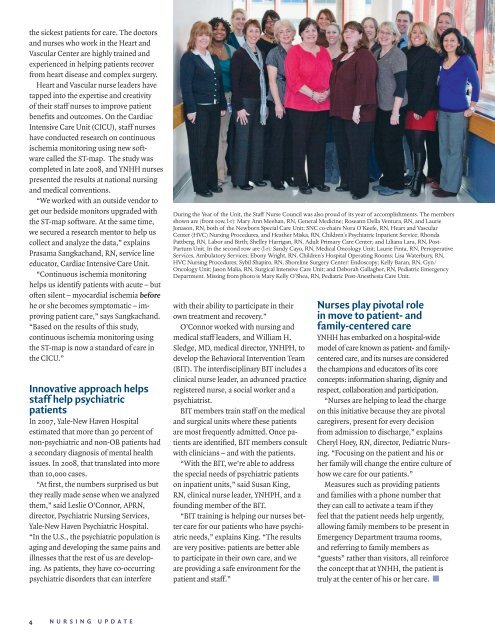
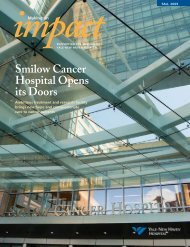


![Annual Report Donor Listings [pdf] - Yale-New Haven Hospital](https://img.yumpu.com/49673575/1/190x245/annual-report-donor-listings-pdf-yale-new-haven-hospital.jpg?quality=85)

